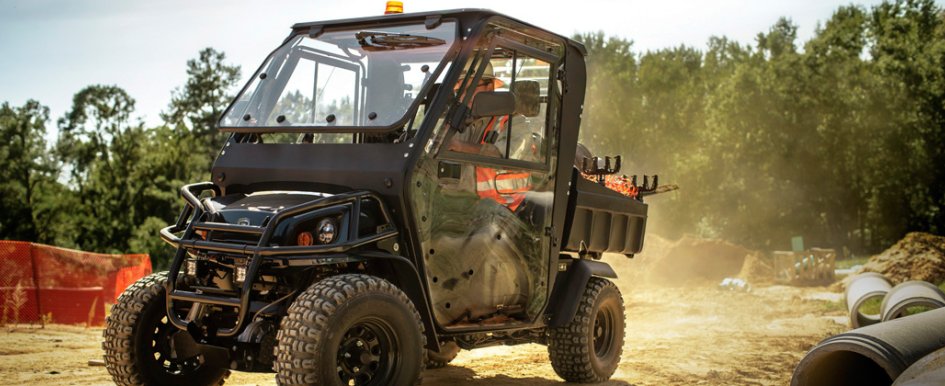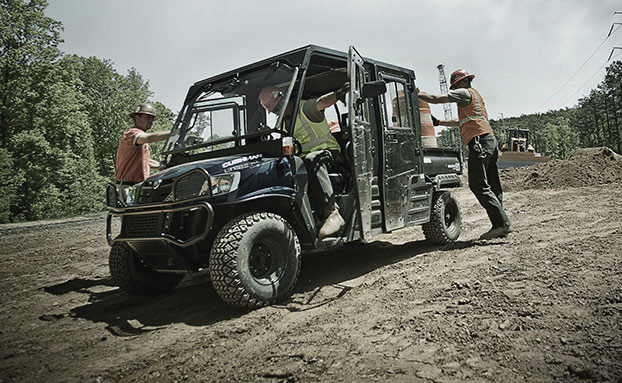
One common thread on any jobsite is an emphasis on crew safety, no matter the crew size, scope of work or site environment. Many companies strive to foster a safety culture with a zero-accident policy, since even a minor incident could cause a long-term injury and a significant expense. With more utility vehicles (UTVs) on jobsites than ever before, making UTV safety a top priority is critical. Consider the following steps to enhance productivity in your UTV fleet.
1. Follow maximum weight guidelines
Properly loading a UTV ensures that the operator and all passengers remain safe in transit and prevents unnecessary damage to the vehicle. But correct loading practices can easily be overlooked as workers hurry to a jobsite, leading to dangerous conditions for both the crew and vehicle. One common mistake occurs when operators overload UTVs by not accounting for passenger weight when calculating total vehicle payload.
For example, a vehicle with a total payload capacity of 1,500 pounds is often filled with as much material in the bed, before the two-person crew even takes a seat. This means the vehicle is operating with a payload above the recommended maximum weight. That extra cargo weight is costly and puts both the workers and vehicles at risk. While many UTVs do not have maximum capacity indicators on the vehicle body, crews need to be aware of each vehicle's recommended capacity.

2. Maintain appropriate speed
Getting the job done quickly may increase productivity, but speed should never come before crew safety. This is especially true when navigating the rough terrain of a construction site. When driving a UTV loaded to maximum capacity, it is important for crew members to drive slowly and turn smoothly to minimize the risk of a vehicle overturn. In addition, driving on steep slopes should be avoided unless absolutely necessary.
Some UTV manufacturers are upping the ante on speeding by providing a factory-installed ground speed governor option. The mechanical device enables site managers to set a maximum flat ground speed for vehicles and prevents the engine from ever exceeding that speed.
3. Stay focused & avoid distractions
It takes just a moment of distraction to overlook a passerby or a patch of rough terrain. To keep your crew safe at all times, it is important to clamp down on distractions among UTV operators, especially the use of cell phones and two-way radios while driving. UTV operators must be alert and aware of potential hazards at all times, especially while in transit.
4. Perform a daily inspection
It's also essential that vehicles are in safe working order prior to loading. A walk-around inspection every morning before work takes less than 5 minutes and ensures the vehicle is functioning properly.
To conduct a quick inspection, UTV operators should check that the windshield is clean and clear, the dump bed is in proper working order and the tires are fully inflated. It is also recommended the operator remove any debris from the vehicle's headlights.
5. Enhance safe practices with optional accessories
A firm understanding of how to use UTVs safely—and the responsibilities of the operator\'97will go a long way toward creating a safer environment for everyone on the jobsite. Manufacturers also offer an array of accessories or attachments designed to keep crews safe while on the jobsite.
The most popular add-ons are accessories that alert others when vehicles are in use. Taillights, brake lights, reverse alarms, work lamps and side mirrors are simple, low-cost additions. They go a long way to ensure operator safety, especially during the early morning or on worksites where tall foliage may shield a vehicle from view.
A rollover protection system (ROPS) prevents passengers from injury in the event of a rollover. Additionally, an occupant protection system (OPS) protects operators when a vehicle tips over. These accessories may not come standard on some vehicles, so it can be a worthwhile upgrade for vehicles that work on larger construction sites.
Another option is a full-cabin enclosure, which ensures passengers' arms and legs do not hang out of the vehicle in the event of a roll. If a vehicle starts to tip, it's instinctual to reach an arm out to brace the fall, but this can lead to injury. Similarly, a wind stopper or rear screen creates a barrier between the cab and bed and prevents materials from entering the cab area, which could hinder the drive's vision.
UTVs play an important role in enhancing productivity on construction sites, but they should be operated with care. Promoting safe vehicle usage will go a long way to fostering a culture of safety on the jobsite and ensuring your crew and equipment stay out of harm's way.
